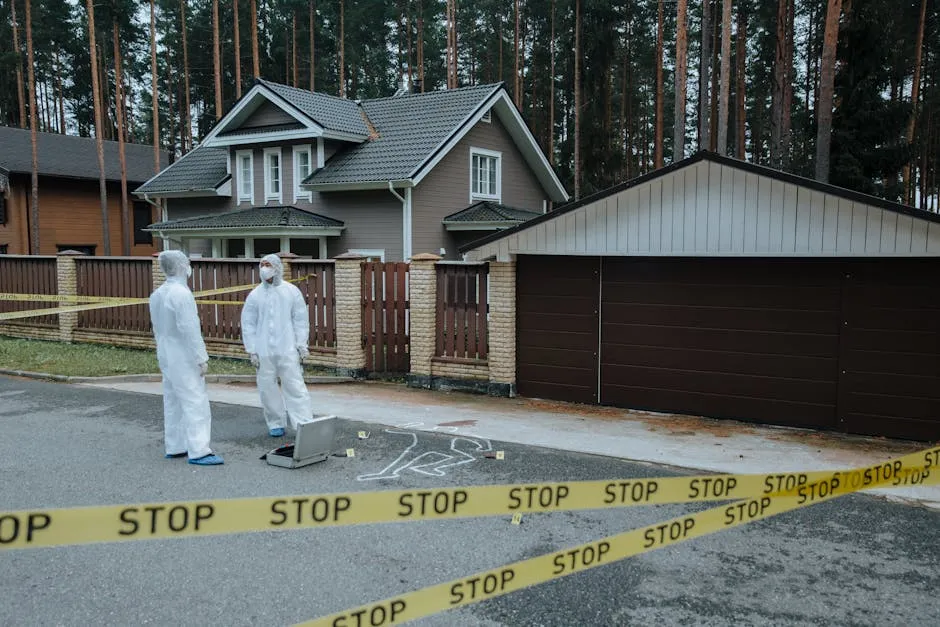Introduction
Staten Island, the least populated borough of New York City, often flies under the radar. With a population of around half a million, it’s a unique blend of suburban charm and urban challenges. While it’s famous for its parks and picturesque views, this quaint island also faces its fair share of crime. Understanding crime statistics is crucial for current residents and those considering a move to this borough. After all, knowledge is power, especially when it comes to safety.
For anyone thinking about relocating, crime rates can be a deal-maker or breaker. Families want to know if they can stroll through their neighborhoods without a worry. Potential movers need insight into local safety. This article aims to provide a detailed overview of crime statistics in Staten Island. We’ll compare these figures with national averages and other NYC boroughs. Additionally, we’ll discuss trends and perceptions surrounding safety.
By the end, you’ll have a clearer picture of Staten Island’s crime landscape and might even find yourself contemplating that move—or not! And while you’re at it, don’t forget to grab a copy of Crime and Punishment by Fyodor Dostoevsky to see how literature often mirrors the challenges of society.

Crime Overview
General Crime Statistics
Staten Island’s crime rate stands out, often appearing higher than the national average. According to recent data, the total crime rate is roughly 16 per 1,000 residents. To put that into perspective, the violent crime rate sits at approximately 5 per 1,000 inhabitants, while property crime is about 11 per 1,000. This means that the chance of becoming a victim of crime in Staten Island is approximately 1 in 64.
When we compare Staten Island to the national median, the violent crime rate is slightly elevated. For instance, the national median for violent crime is about 4.0 per 1,000 residents, while Staten Island’s is at 4.51. However, property crime rates are more favorable. Staten Island’s property crime rate is 11.17 per 1,000 residents, significantly lower than the national median of 20.
In total, Staten Island reported around 7,773 crimes, with 2,235 classified as violent and 5,538 as property crimes. The overall crime rate may sound alarming, but it’s essential to understand the context. Staten Island often ranks as one of the safer places to live compared to other cities of similar population size. If you’re interested in learning more about crime statistics, consider checking out The Complete Idiot’s Guide to Understanding Crime Statistics.
Sources like NeighborhoodScout and the NYPD highlight these statistics, painting a multifaceted picture of crime in Staten Island. Despite the numbers, many residents report feeling relatively safe, especially in certain neighborhoods. Understanding these statistics helps us grasp the local safety climate better.
As we dive deeper into the nitty-gritty of Staten Island’s crime statistics, it’s crucial to remember that numbers don’t tell the entire story. They provide a framework, but personal experiences and community initiatives play a significant role in shaping perceptions of safety. For those wanting to enhance their personal security, consider a Personal Safety Alarm Keychain that can be a lifesaver in tricky situations.

Comparison with National Averages
When comparing Staten Island’s crime rates to national figures and other New York City boroughs, a mixed picture emerges. Staten Island boasts a violent crime rate of approximately 5 per 1,000 residents, which is slightly above the national median of 4 per 1,000. This means that in Staten Island, your chances of becoming a victim of violent crime are about 1 in 222. While this may sound alarming, it’s crucial to remember the broader context.
In contrast, Staten Island’s property crime rate stands at around 11 per 1,000 residents, significantly lower than the national average of 20 per 1,000. This statistic suggests that property crimes, such as burglary and theft, are less likely to occur in Staten Island compared to many other areas across the country.
When we stack Staten Island against its NYC counterparts, the differences become even clearer. For instance, Brooklyn’s violent crime rate is higher, hovering around 6 per 1,000 residents. However, Staten Island’s overall crime rates can vary widely across neighborhoods, leading to different perceptions of safety among residents.
For visitors and newcomers, understanding these numbers can be enlightening. While Staten Island may appear to have a higher violent crime rate at first glance, its property crime rates tell a different story, signaling that the likelihood of home invasion or theft is relatively low. If you’re looking to boost your home security, consider investing in a Home Security Camera System to keep an eye on your property.
Ultimately, these comparisons are not just numbers; they carry implications for everyday life. Residents may feel a sense of security knowing that property crimes are less frequent, while being aware of the potential for violent incidents can foster caution in certain situations.

Breakdown of Violent Crimes
Staten Island’s violent crime landscape includes several key categories: murder, rape, robbery, and assault. Each category presents unique statistics and trends that reveal the borough’s safety climate.
Starting with murder, Staten Island recorded two homicides in the first half of 2024, a drastic decrease from 11 in 2023. This 82% drop is significant and suggests that law enforcement efforts are yielding results. The homicide rate stands at around 0.03 per 1,000 residents, lower than many urban areas.
Rape statistics show a more troubling trend. Reports indicate 29 incidents in 2024, up from 21 in 2023. This rise, while concerning, may also reflect increased willingness among victims to report such crimes, shedding light on an often-hidden issue. To better understand the complexities of crime and safety, check out The Gift of Fear: Survival Signals That Protect Us from Violence by Gavin de Becker.
Robbery is another category worth noting. The borough saw 149 robberies reported in 2024, down 5% from the previous year. This decline indicates that community safety initiatives and police strategies are effectively reducing such incidents.
Assaults, however, have taken a different turn. With 466 reports in 2024, there’s a 5% increase compared to 442 in the same period last year. This uptick could be linked to various social factors, such as economic pressures or community dynamics, and highlights the need for continued vigilance. Consider reading Crime Prevention Through Environmental Design (CPTED) Handbook for insights on creating safer spaces.
In summary, the breakdown of violent crimes in Staten Island reveals a complex picture. While murder rates plummet, other categories, especially rape and assault, require ongoing attention and community engagement. Residents must remain informed and proactive to foster a safer environment for all.

Safety Perceptions and Community Response
Staten Island’s residents often find themselves navigating a complex emotional landscape regarding safety and crime. According to a recent survey, about 59% of locals feel “pretty safe,” while 18% report feeling “very safe” in their neighborhoods. These statistics reveal that, while there are some concerns, many residents maintain a sense of security amidst the occasional headlines of crime.
Interestingly, perceptions of safety can vary significantly by neighborhood. Areas like Eltingville and Woodrow North rank as some of the safest spots on the island, often cited in community discussions. Meanwhile, more crime-prone areas, such as Port Richmond and Stapleton, are reminders that not all corners of Staten Island feel equally secure.
Community initiatives play a crucial role in shaping these perceptions. The NYPD has implemented several strategies aimed at reducing violent crime. For instance, the “Neighborhood Policing” program fosters closer ties between officers and residents. Officers are more visible and accessible, encouraging locals to report suspicious activities without fear.
In addition to police efforts, community-led initiatives, such as neighborhood watch programs, have gained traction. These grassroots efforts empower residents to take an active role in their safety, fostering a culture of vigilance and mutual support. A recent poll highlighted that 31% of residents view law enforcement as “very visible and very responsive,” indicating a level of trust in local police efforts. Want to ensure your safety? Consider investing in a Pepper Spray for Self Defense.
Despite the statistics, it’s essential to recognize that perceptions of safety often differ from reality. The overall crime rate may be higher than national averages, but many residents choose to focus on their communal bonds and proactive measures.
In the face of rising crime rates, Staten Islanders have shown resilience. They’re not just sitting back; they’re taking action. From organizing community meetings to discuss safety concerns to participating in local crime prevention programs, residents are committed to creating a safer environment for everyone.
Ultimately, safety perceptions in Staten Island reflect a blend of statistics, community engagement, and individual experiences. As residents navigate these waters, they continue to weave a tapestry of vigilance and community spirit. With ongoing efforts from both law enforcement and the community, Staten Island can look forward to maintaining and even enhancing its safety landscape.

Neighborhood Safety Comparisons
Staten Island boasts some neighborhoods that shine bright in terms of safety. Let’s take a look at the safest spots, where residents can feel secure while enjoying their daily routines.
First up, Eltingville leads the pack! This neighborhood has a reputation for its low property crime rates, thanks to community vigilance and active neighborhood watch programs. Residents frequently organize events to foster a sense of community. They believe that knowing your neighbors is the best crime deterrent. If you’re curious about the history of crime and its representation in media, check out The Crime Book: Big Ideas Simply Explained.
Next, we have Woodrow North. This area is also renowned for its safety. Residents here actively participate in local safety initiatives, keeping crime at bay. Community members often gather to discuss safety measures and share tips on securing their homes.
Tottenville South is another gem. This neighborhood combines a tight-knit community with low crime rates. Families often stroll through parks and enjoy neighborhood barbecues, creating a welcoming atmosphere. The locals are proud of their community policing efforts, which emphasize building trust between residents and law enforcement. For those who want to be prepared for emergencies, consider an Emergency First Aid Kit to have on hand.
Alverson Ave / Barrow Pl is on the list too! This area has seen a significant reduction in property crime, largely due to residents taking action. They’ve established a strong relationship with local police, leading to a noticeable drop in incidents.
Blue Heron Park and Woodrow West also deserve a mention. Both neighborhoods emphasize safety through community engagement. Residents often organize clean-up days and safety fairs, fostering pride in their surroundings while discouraging criminal activity.
In addition to these neighborhoods, areas like Freedom Ave / Rivington Ave and New Dorp North have taken proactive measures to maintain safety. They focus on community-building events and educational programs about crime prevention. For those looking to enhance their outdoor security, consider installing Outdoor LED Motion Sensor Light.
All these neighborhoods share a common theme: proactive involvement. Residents take pride in their communities and work together to keep crime at bay. Their efforts not only foster a sense of belonging but also create safe spaces for families and individuals alike.

Recent Trends and Future Projections
Analysis of Recent Data
The first half of 2024 has brought some noteworthy changes to Staten Island’s crime statistics. According to the latest reports, overall crime has decreased by 3% compared to the same period in 2023. This decline is a positive indicator of community safety and effective policing strategies.
Let’s break this down a bit. Homicides, for instance, have seen a dramatic drop. Staten Island recorded just two homicides in 2024, down from eleven the previous year. This staggering 82% decrease demonstrates the impact of focused crime prevention efforts by local law enforcement.
However, not all categories followed this downward trend. Rape incidents increased to twenty-nine from twenty-one, a 38% rise. This uptick could indicate a growing willingness among victims to report these crimes, highlighting the need for continued awareness and support for survivors. To stay informed about local safety, consider reading the Emergency Preparedness Handbook.
Robberies also experienced a slight decline, with 149 reported in 2024, compared to 156 in 2023, representing a 5% drop. This reduction indicates that community vigilance and law enforcement strategies are effectively working.
Unfortunately, felony assaults have seen a 5% increase, rising from 442 to 466 incidents. This increase warrants attention, as it suggests underlying social pressures that could be influencing violent behavior within the community. Additionally, having a Tactical Flashlight on hand can be a smart choice for personal safety.
Overall, the crime landscape in Staten Island is complex. While some categories show improvement, others require continued focus and proactive measures. As law enforcement strategies evolve, community engagement remains crucial in fostering a safer environment for all residents.

Future Projections
As we gaze into the crystal ball of Staten Island’s crime landscape, exciting possibilities emerge. The current data indicates a slight decline in overall crime, suggesting that strategic law enforcement initiatives are making a difference. The NYPD’s tactical shift in late 2023, which emphasizes community engagement and data-driven policing, is likely to continue shaping crime trends.
Community involvement is crucial. When residents actively participate in local safety initiatives, the results can be remarkable. Programs like neighborhood watches foster relationships between police and community members. These connections often lead to increased trust and a shared commitment to maintaining safety. As more residents become vigilant, crime rates may further decline.
Additionally, law enforcement’s focus on specific crime categories, like car theft and burglary, could prove effective. By analyzing data and targeting high-crime areas, police can allocate resources more efficiently. This proactive approach may deter criminal activities, leading to a safer Staten Island. For peace of mind, consider installing a Home Security System with App Control.
Moreover, ongoing dialogues about safety can empower residents. When people feel informed and involved, they are more likely to report suspicious activities. This heightened awareness can create a ripple effect, dissuading would-be criminals and enhancing community resilience.
Looking ahead, the combination of law enforcement strategies and community engagement presents a promising outlook for Staten Island. If current trends continue, residents can anticipate a future with lower crime rates and a stronger sense of safety. Recent trends in data analysis for financial forecasting 2024 may also provide insights into broader societal impacts on crime.
Understanding recent trends in crime can help residents feel more informed and secure. Learn more about recent trends.

Conclusion
In summary, Staten Island’s crime statistics reveal a complex yet evolving safety landscape. The borough shows a higher overall crime rate than the national average, but it’s essential to recognize the nuances within these numbers. With a violent crime rate of 5 per 1,000 residents and property crime at 11 per 1,000, Staten Island presents both challenges and opportunities for improvement.
The positive news lies in recent trends indicating a decline in specific crime categories, such as homicides and robberies. Community engagement and focused law enforcement strategies have played pivotal roles in these developments. Despite the uptick in certain violent crimes, like rape and assault, the overall trend suggests that Staten Island is moving in the right direction.
Understanding crime statistics is vital for residents and potential movers alike. Knowledge empowers individuals to make informed decisions about their safety and contributes to a sense of community. Each neighborhood has its unique safety profile, and awareness can guide choices about where to live and how to engage with local safety initiatives. For a comprehensive understanding of safety, consider checking out Safety First: A Comprehensive Guide to Personal Safety.
Encouraging community involvement is crucial. Residents are more likely to feel secure when they actively participate in safety measures. Whether through neighborhood watches, community meetings, or simply getting to know one another, these efforts create a more vigilant and connected community.
As Staten Island continues to adapt and evolve, fostering a culture of collaboration between law enforcement and residents will be key. By working together, both entities can create a safer environment, ultimately enhancing the quality of life for everyone on the island. And don’t forget, a Smart Lock for Home Security can add an extra layer of protection.

FAQs
Is Staten Island safe compared to other boroughs?
Generally, Staten Island is considered safer than other boroughs like Brooklyn. With a serious crime rate of 6.6 per 1,000 residents, it stands out as one of the safer options in New York City. Residents often report feeling secure, especially in neighborhoods like Eltingville and Woodrow North, which boast low crime rates.
What are the safest neighborhoods in Staten Island?
Some of the safest neighborhoods include Eltingville, Woodrow North, and Tottenville South. These areas enjoy low property crime rates and active community engagement, contributing to their reputation as safe havens. Residents often participate in safety initiatives that foster a sense of belonging and security.
Are crime rates increasing or decreasing in Staten Island?
Recent reports indicate that Staten Island has experienced a 3% decrease in crime compared to the same period in 2023. While some categories, like rape and felony assaults, saw increases, the overall trend points towards improved safety due to effective law enforcement strategies and community involvement.
What can residents do to stay safe?
Residents can enhance their safety by participating in neighborhood watch programs, staying informed about local crime trends, and fostering community connections. Regularly communicating with law enforcement and reporting suspicious activities can also contribute to a safer environment.
Please let us know what you think about our content by leaving a comment down below!
Thank you for reading till here 🙂
All images from Pexels




